Although the Energy Information Administration reported four consecutive increases in crude oil and fuel inventories (since our previous Oil Investment Update was posted), oil investors shrugged off these bearish numbers and focused on growing signs of coordinated OPEC and non-OPEC producers’ cuts in oil output. On top of that, U.S. drillers added 61 rigs since mid January, but this negative development was overshadowed recently by news that President Trump will impose new sanctions on dozens of Iranian individuals for their supposed role in missile development and terrorism. In this environment light crude came back to the key resistance zone created by the December and January highs, but will we see further improvement in the following weeks? Let’s jump right into charts (charts courtesy of http://stockcharts.com) and try to find an answer to this question.
Crude Oil
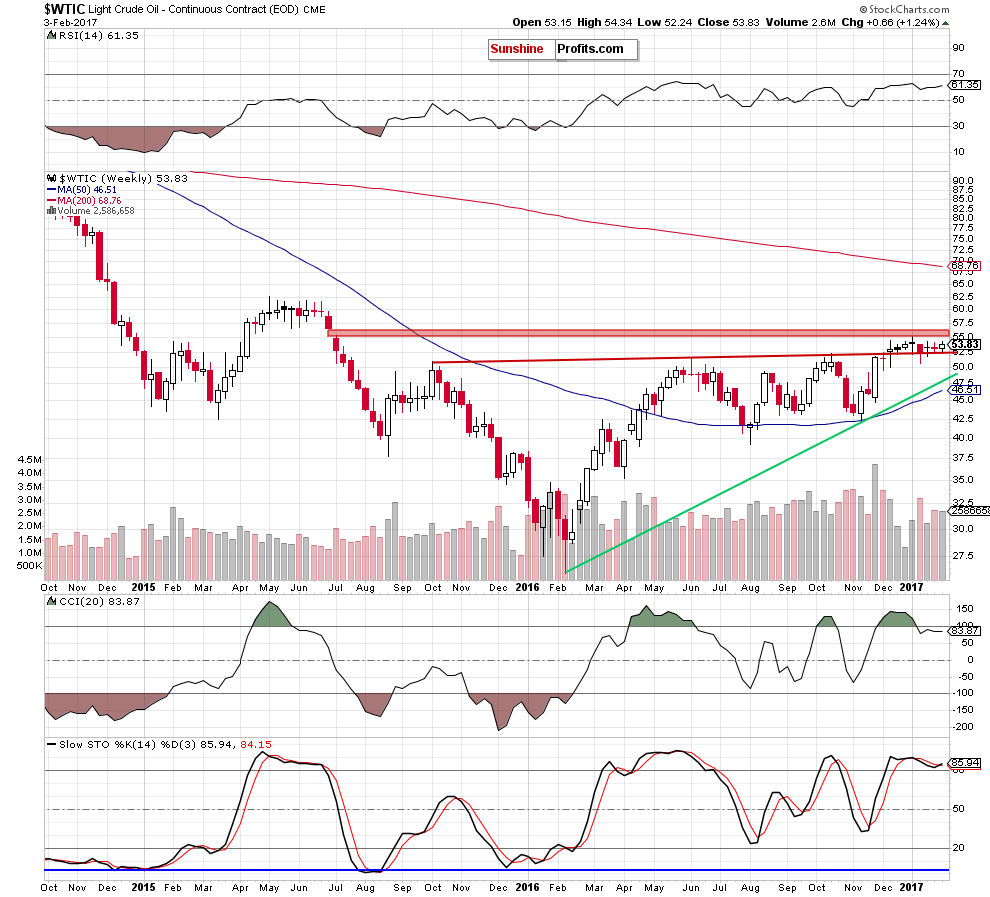
On the medium-term chart, we see that although crude oil closed another week above the previously-broken long-term red line, the commodity is still trading below the red gap (created at the beginning of Jul 2015), which continues to keep gains in check since the beginning of the year.
Will the very short-term picture give us more clues about future moves? Let’s check.
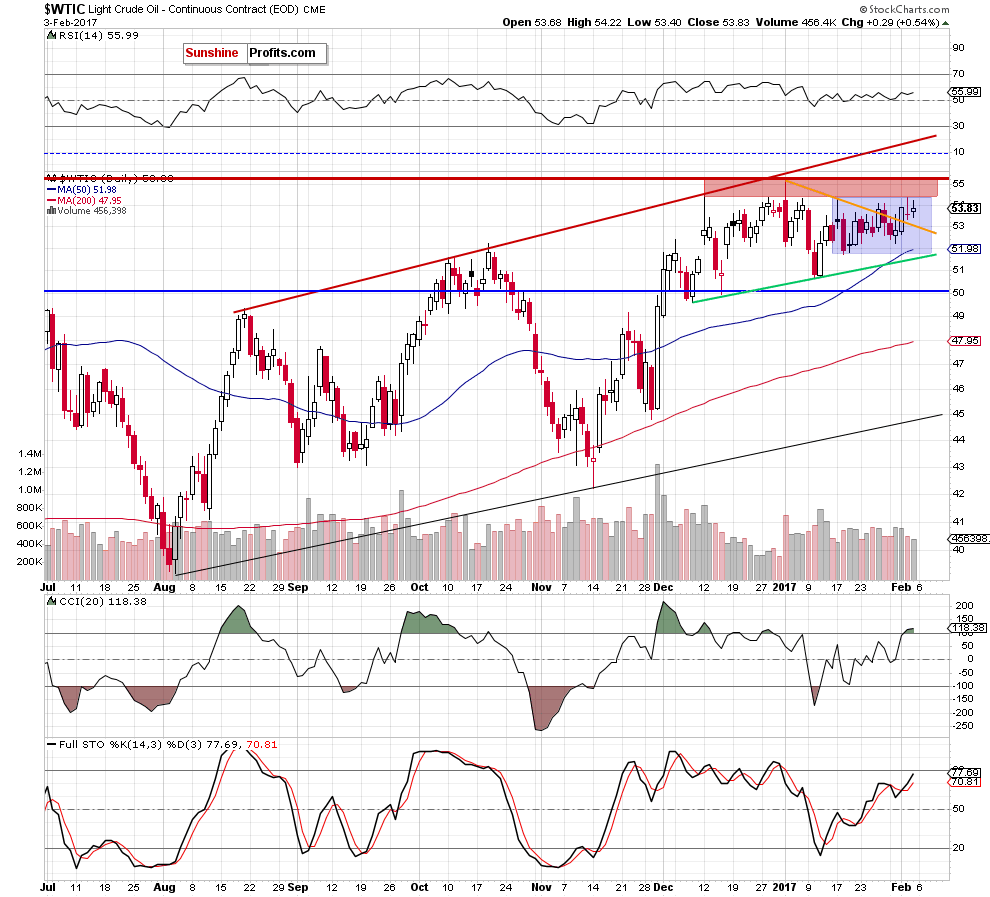
Looking at the daily chart, we see that although crude oil extended gains at the end of the previous week, light crude is still trading in the blue consolidation under the red resistance zone (created by the December and the January highs).
This suggests that the space for gains is limited – especially when we factor in the fact that the commodity created the triple top formation (created by the January 6, January 17 and Feb 2 peaks), which reinforces the above-mentioned resistance area.
Additionally, the size of volume that accompanied Friday’s increase was smaller than day earlier (during the decline), which may be the first sign of oil bulls’ weakness. If this is the case and we saw a pullback from the current levels, the initial downside target would be the lower border of the blue consolidation and the green support line based on the December and January lows (around $51.70).
Summing up, the outlook for oil is bearish as crude oil remains under the previous highs and the red gap, which together continue to keep gains in check since the beginning of the year.
Having discussed the situation in crude oil, let’s examine the NYSE Arca Oil Index (XOI) to find out what the current outlook for oil stocks is.
Oil Stocks
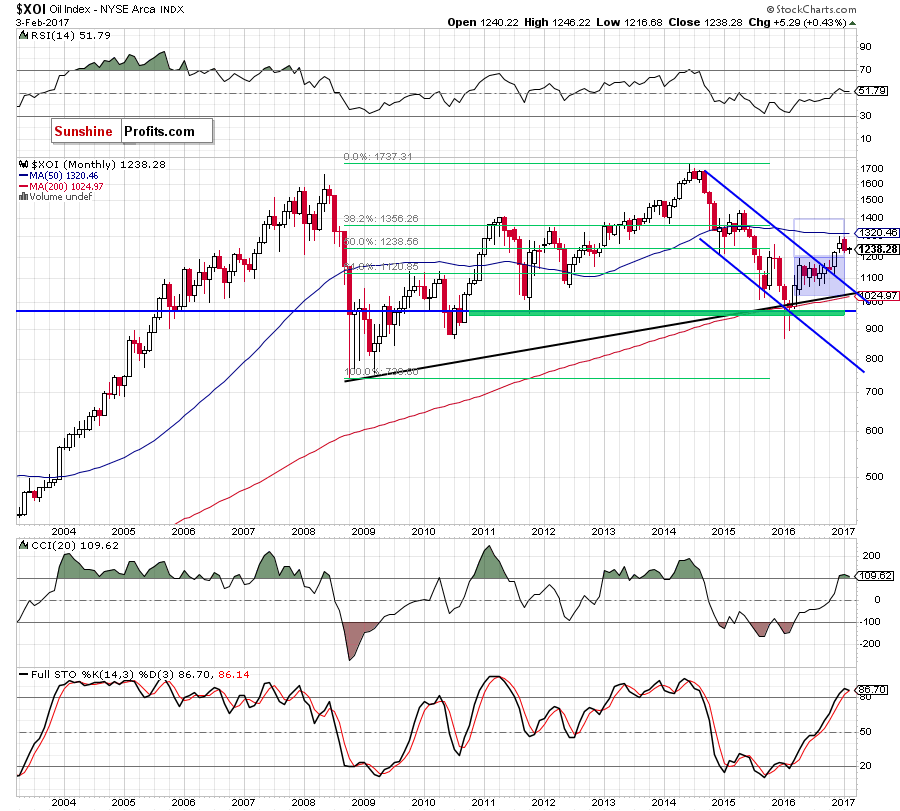
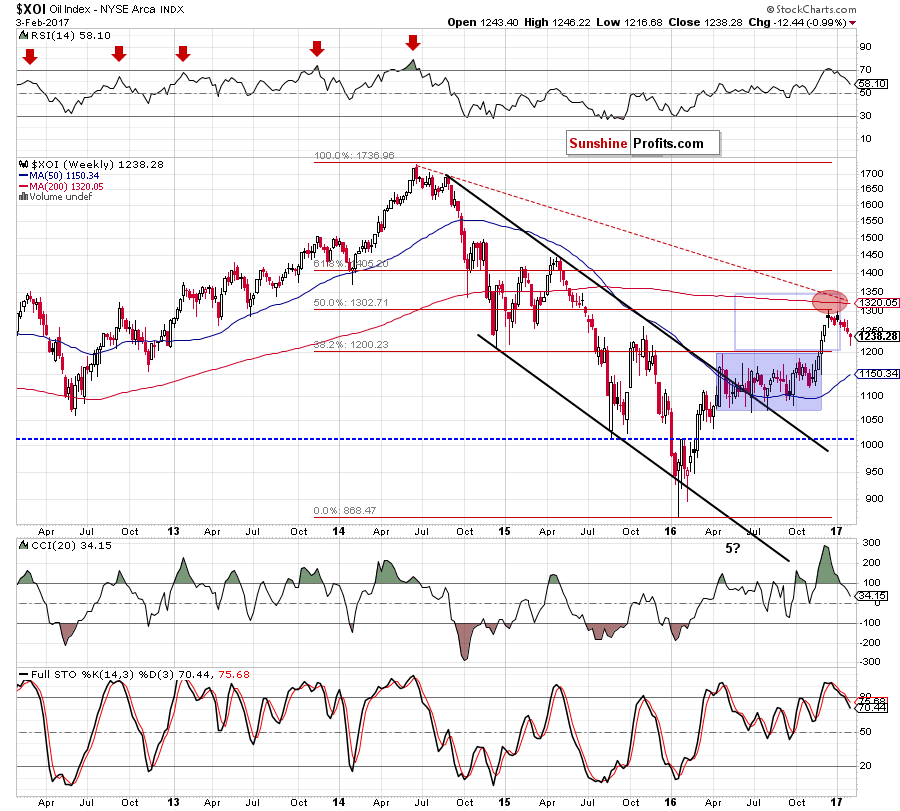
Quoting our previous Oil Investment Update:
(…) oil stocks reached the lower border of our resistance area - the 50% Fibonacci retracement (based on the 2014-2016 downward moves). (…) this resistance encouraged bears to act, which resulted in a pullback (…) all indicators generated the sell signals, which suggest that further deterioration in the coming weeks should not surprise us. (…) How low could the XOI go in the coming weeks? In our, opinion, the initial downside target would be the barrier of 1,200 and the previously-broken Apr 2016 high of 1,194.
From today’s point of view, we see that oil bears pushed the XOI lower as we had expected. With the recent downward move oil stocks approached our initial downside target, hitting an intraweek low of 1,216 in the previous week. What’s next? Although the index rebounded slightly, the sell signals generated by the indicators remain in place, supporting another attempt to move lower and a test of the nearest support zone (created by the barrier of 1,200 and the previously-broken Apr 2016 high of 1,194) in the coming weeks.
Summing up, the outlook for oil stocks remains more bearish than bullish as the sell signals generated by the indicators are still in play, supporting oil bears and another attempt to move lower. If this is the case, we’ll likely see further deterioration and a comeback to the barrier of 1,200 in the following weeks.
Ratio Analysis
Once we know the current situation in crude oil and oil stocks, let’s focus on the relationship between them. What can we infer from the charts below?
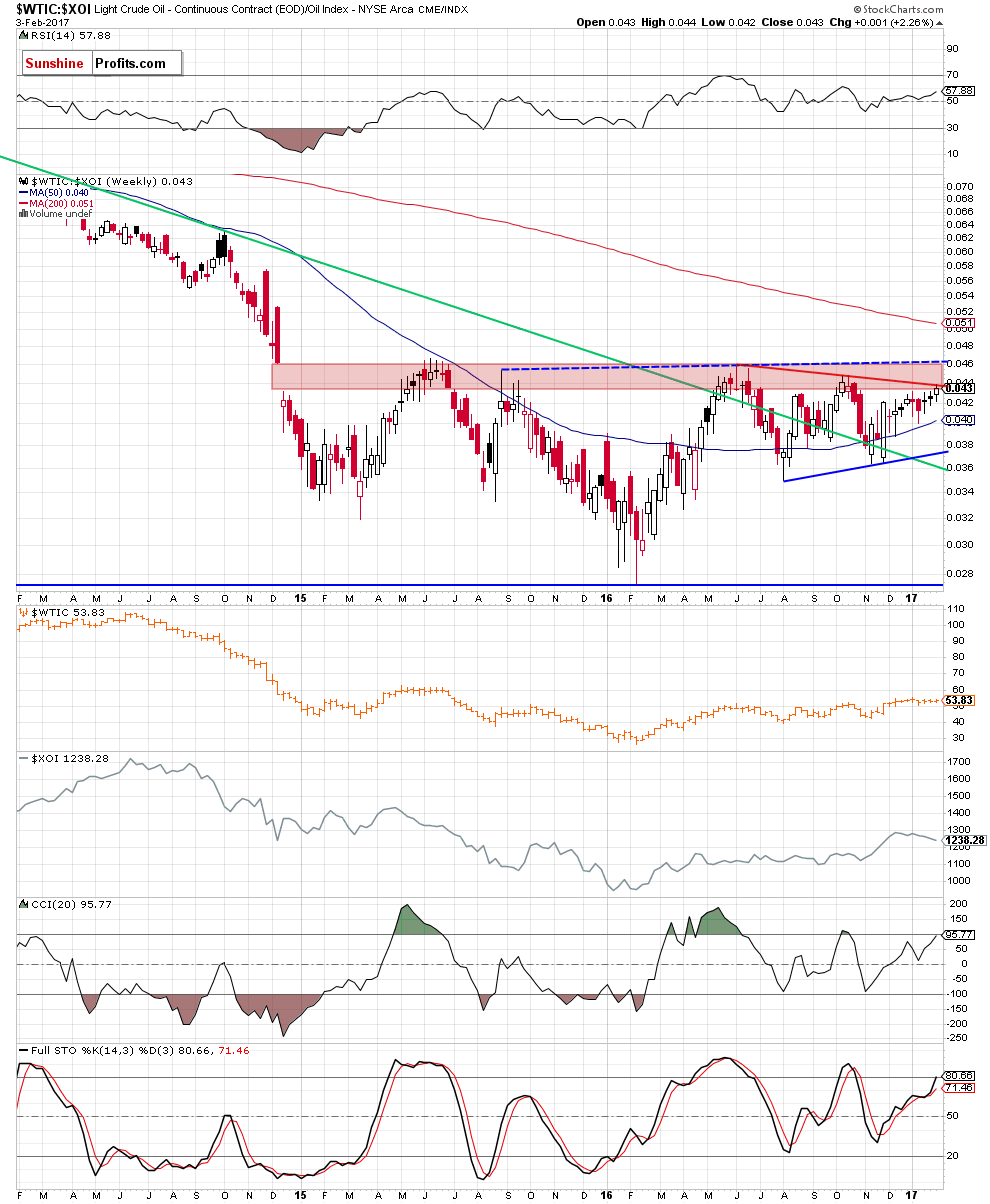
On the weekly chart, we see that although the ratio extended gains in the previous week, the long-term red declining resistance line (based on the June and October highs) together with the red resistance zone stopped oil bulls once again. Taking this fact into account, we believe that our previous commentary is up-to-date also today:
(…) this area (based on the Dec 2014 gap) continues to keep gains in check. Therefore, we think that (…) as long as there are no breakout and a weekly closure above the upper border of the zone (which is currently reinforced by the neck line of a potential reverse head and shoulders formation) further rally is not likely to be seen and another reversal is very likely (not only in the case of ratio, but also in the case of crude oil as strong positive relationship remains in play).
Will the relationship between crude oil and precious metals confirm this pro bearish scenario? Let’s check the chart below and find out.
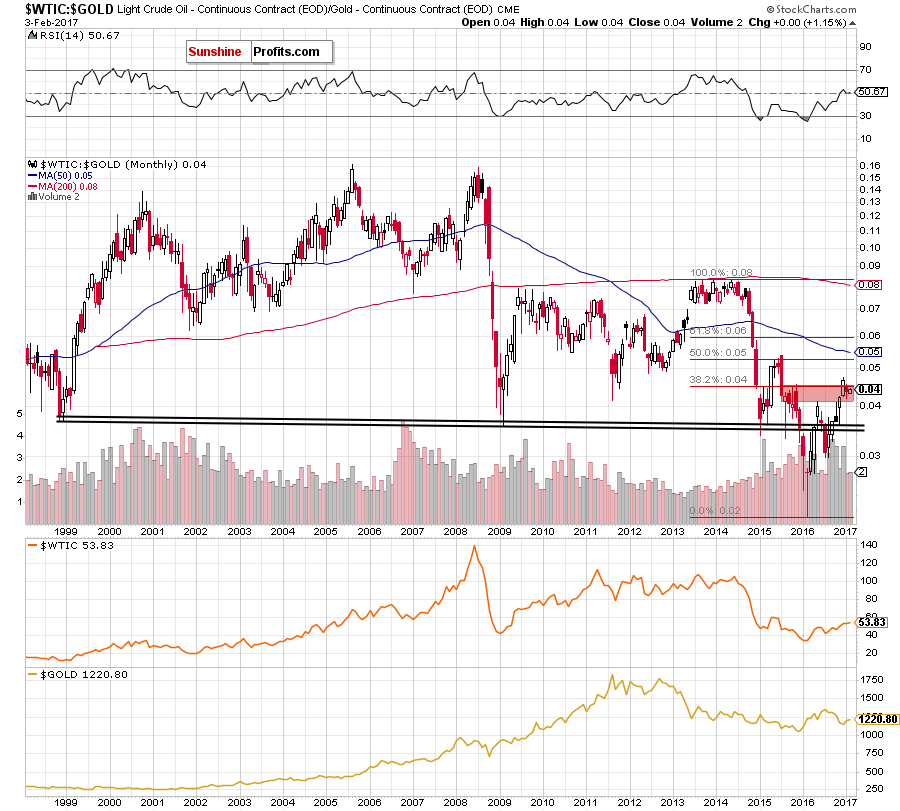
On the long-term chart, we see that the ratio declined and invalidated the earlier breakout above the upper border of the red resistance zone in the previous month, which is a negative event that suggests another attempt to move lower.
How did this price action affect the medium-term picture? Let’s check.
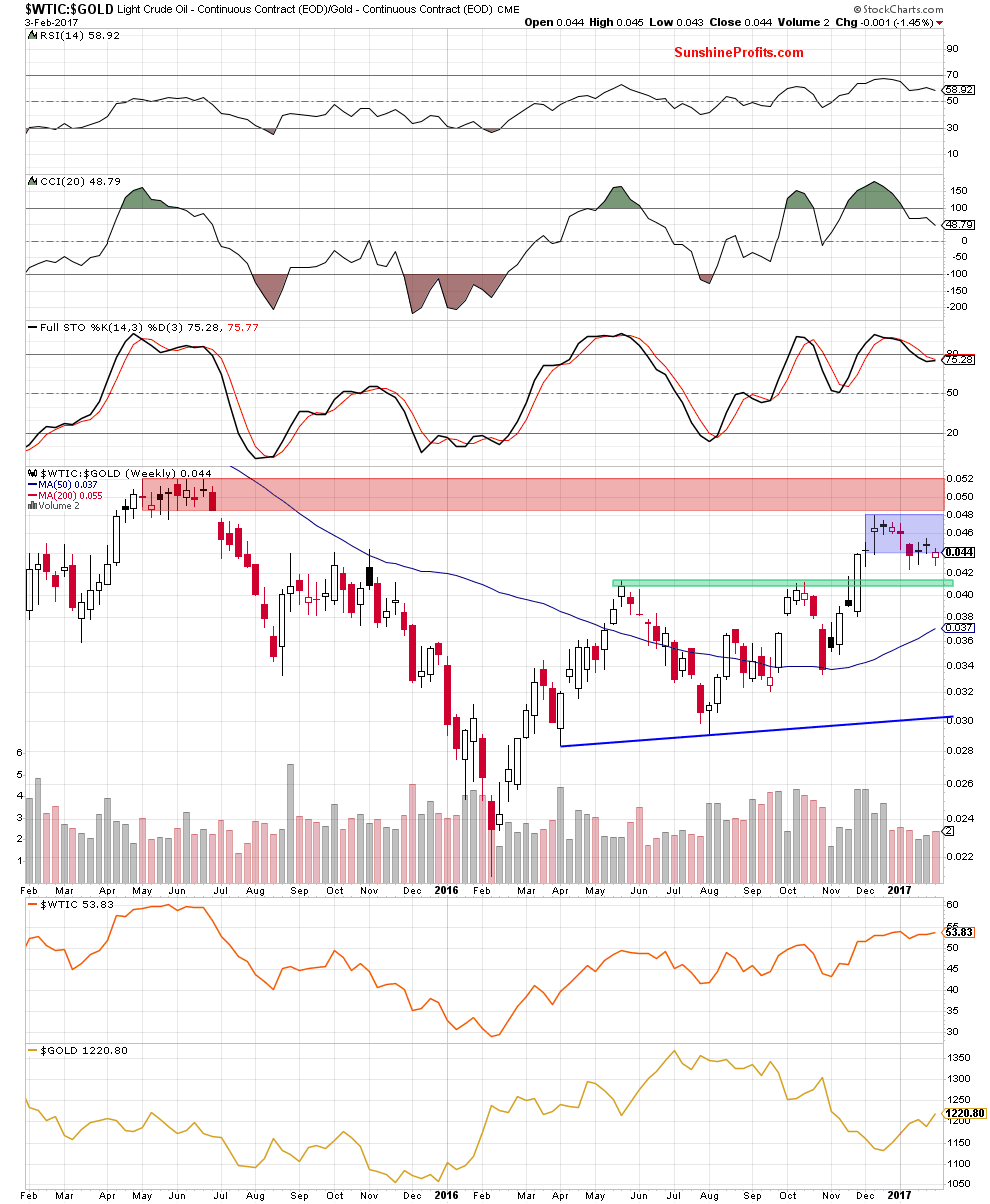
A month ago we wrote the following:
(…) the ratio extended gains and reached the gap created at the beginning of Jul 2015, approaching at the same time to the lower border of the red zone, which is the key resistance at the moment. Additionally, the Stochastic Oscillator generated a sell signal, while the CCI is very close to doing the same, which increases the probability of further declines in the coming weeks.
On the weekly chart, we see that the situation developed in line with the above scenario and the ratio declined, slipping below the lower border of the blue consolidation. Although the bulls managed to invalidate this breakdown, they didn’t hold gained levels, which resulted in another decline. As a result, the ratio closed the previous week slightly below the mid- December low, which looks like a verification of the earlier breakdown. If this is the case, we’ll see further deterioration in the following weeks and a test of the green support zone based on the May and October highs.
What does it mean for crude oil? We believe that the best answer to this question will be the quote from our previous Oil Investment Update:
(…) Taking into account the positive correlation between the ratio and the black gold, a decline in the ratio will likely translate into lower price of light crude in the coming week.
Will the reverse of this ratio give us any additional clues about future moves? Let’s check.
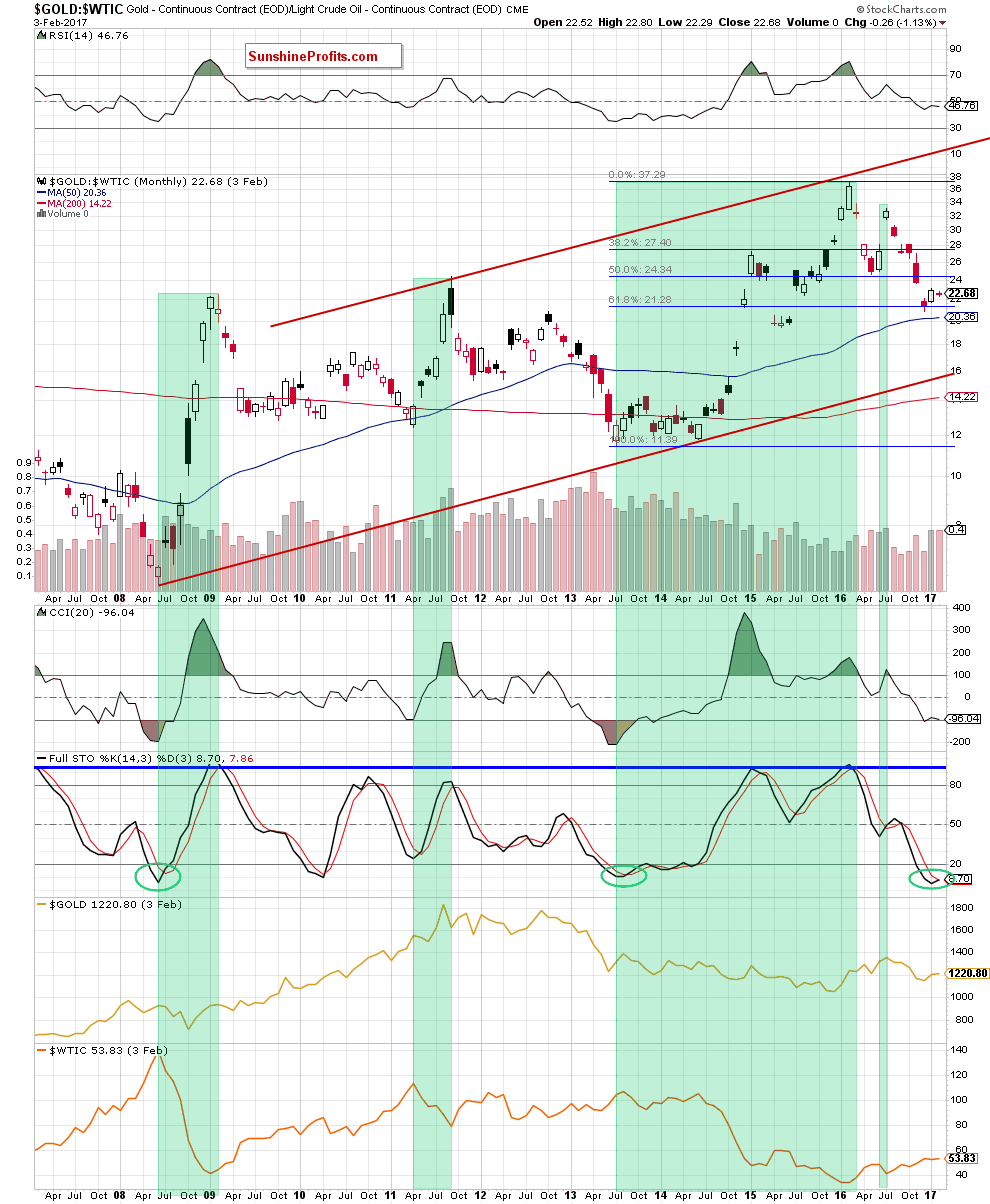
Looking at the above chart, we see that the gold-to-oil ratio slipped slightly below the 61.8% Fibonacci retracement (based on the entire July 2013-February 2016 upward move), but then reversed and rebounded. Thanks to this move the ratio invalidated the earlier small breakdown under this support level, which is a positive signal that suggests further improvement – especially when we factor in the current position of the indicators. As you see, the CCI and the Stochastic Oscillator generated the buy signals, which suggest that another attempt to move higher is just around the corner.
What does it mean for crude oil? As you see on the above charts, may times in the past higher values of the ratio have corresponded to lower prices of light crude. We have seen this strong negative correlation in the second half of June 2008, between April and September 2011, between July 2013 and February 2016 and also between June and July 2016 (we marked all these periods with green), which suggests that another (smaller or bigger) rebound of the ratio will translate into lower values of crude oil in the coming days or even weeks. Therefore, in our opinion, it’s worth to keep an eye on the above chart to receive confirmation of the reversal.
Having said that, let’s take a closer look at the oil-to-silver ratio.
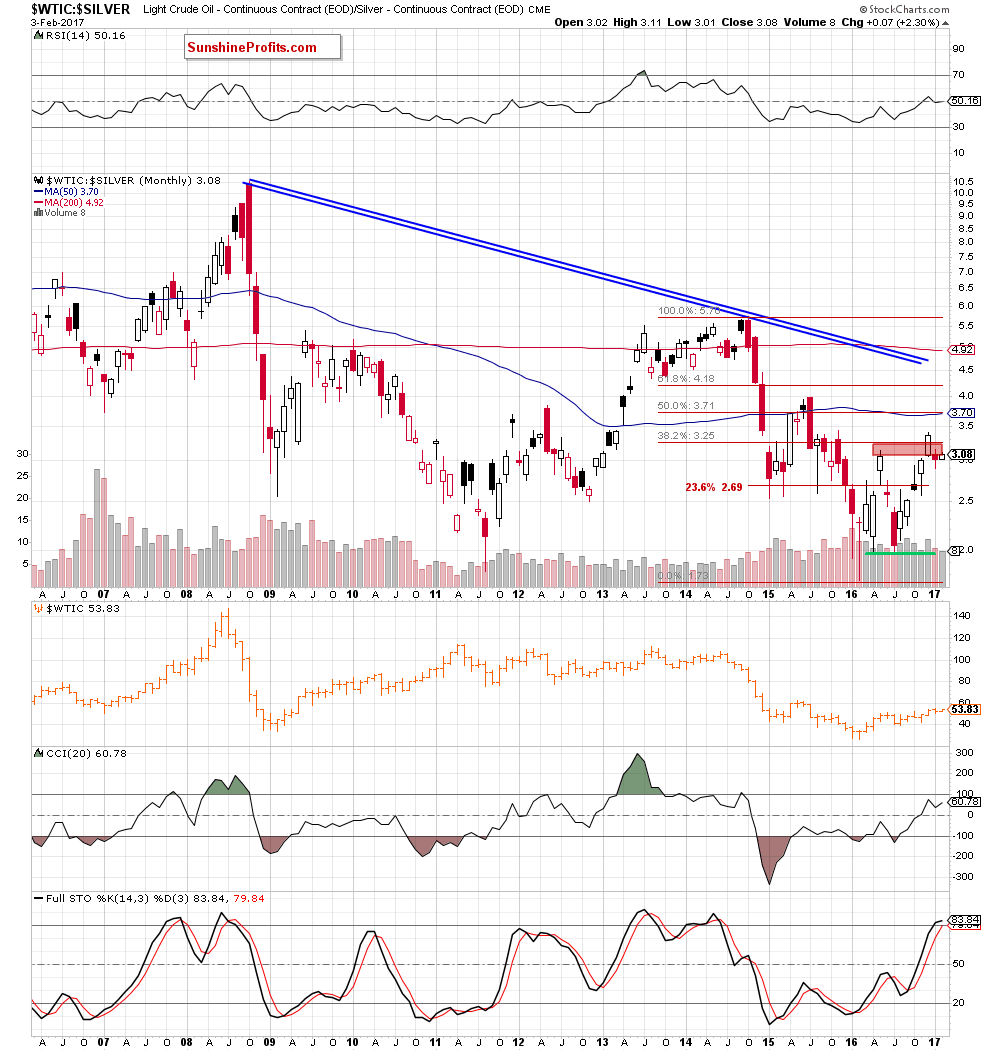
From the long-term perspective, we see that the invalidation of the breakout above the upper border of the red resistance zone and its negative impact on the ratio is still in effect, suggesting another downswing.
Will the medium-term chart give us more bearish signals? Lt’s examine the weekly chart and find out.
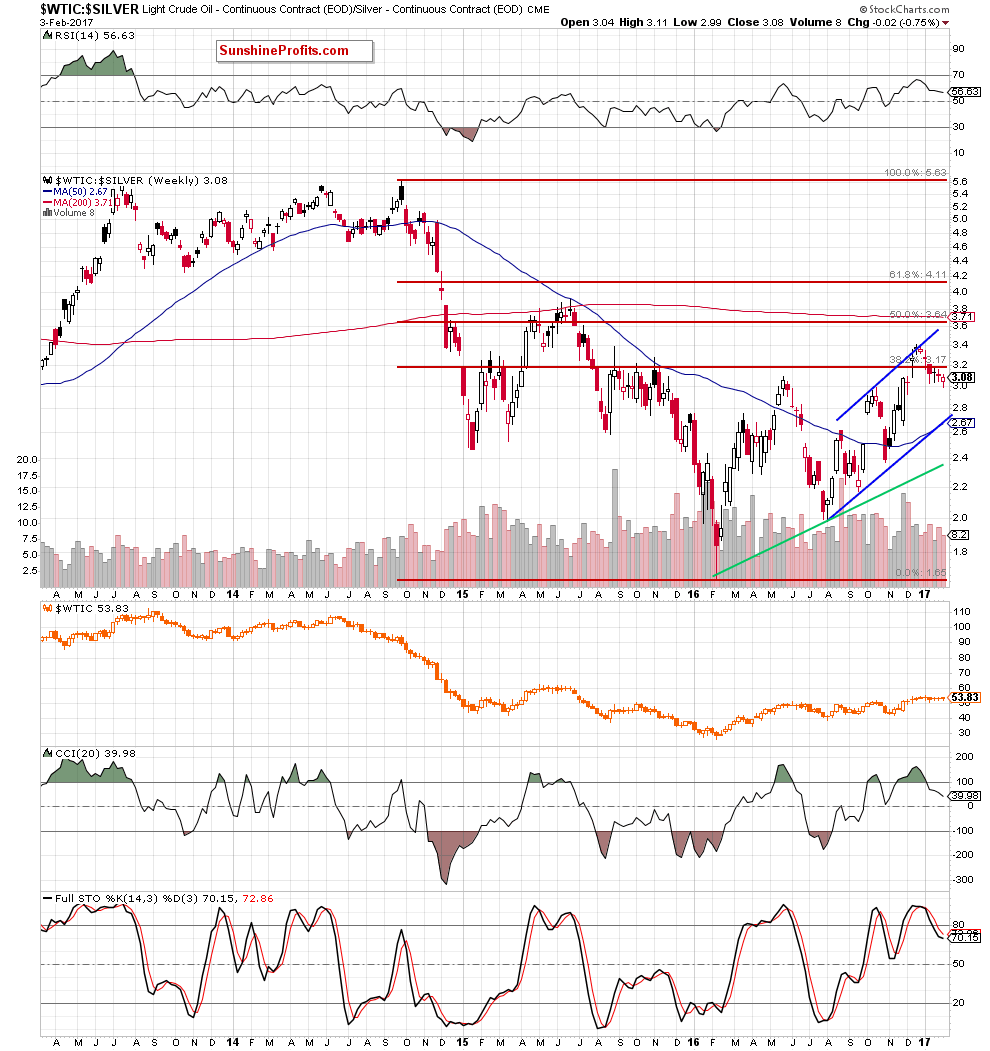
On the weekly chart, we see that the ratio closed another week under the previously-broken 38.2% Fibonacci, which together with the sell signals generated by the indicators suggest further deterioration (in the ratio and also in crude oil) in the coming weeks.
On top of that, when we take a closer look at the daily chart, we’ll another bearish sign.
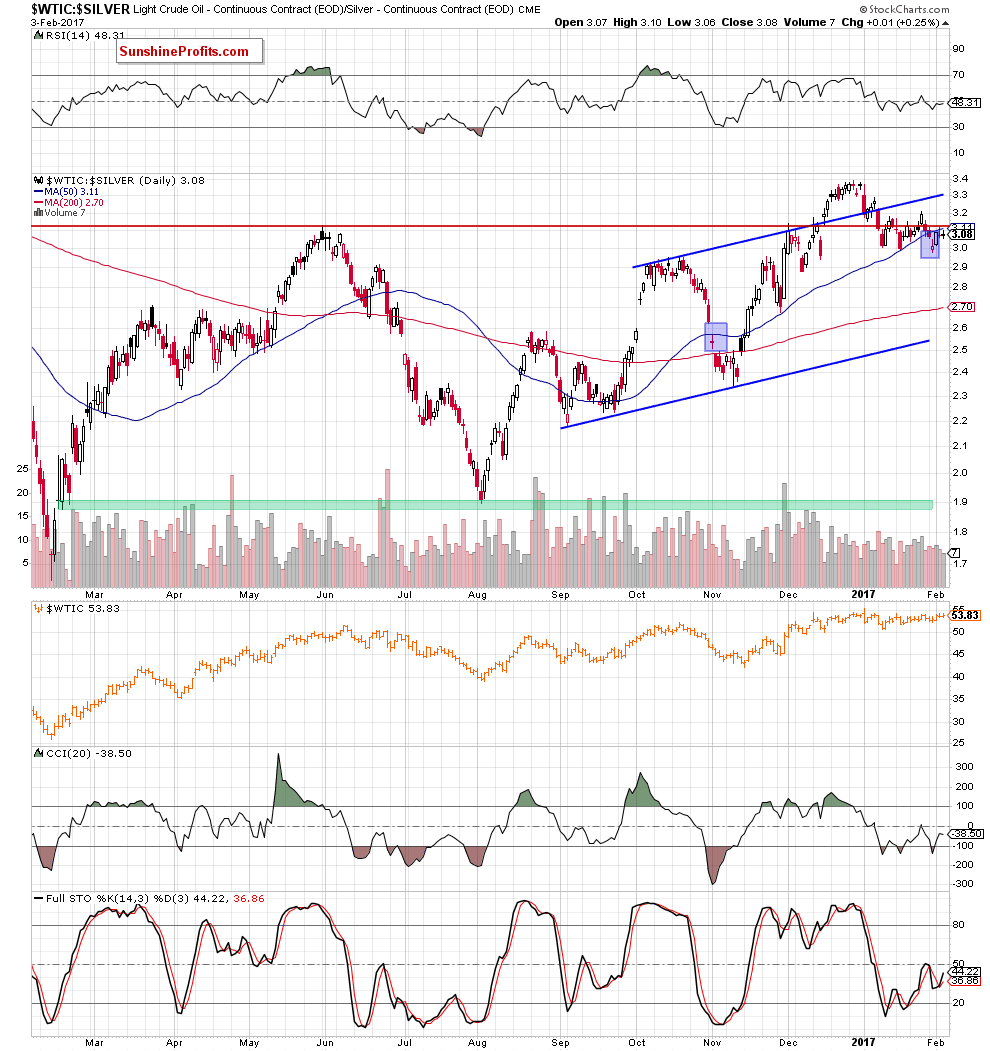
On the very short-term chart, we see that the ratio declined and closed four sessions under the previously-broken 50-day moving average, invalidating the earlier breakout. As you see on the chart, this support stopped the bears several times in the past, which means that the breakdown below it opened the way to lower levels. If this is the case, we’ll see lower values of the ratio and crude oil in the following days as positive correlation between them remains in place.
Non-USD Crude Oil Price
Finishing our today’s ratios’ analysis, let’s take a closer look at the non-USD (WTIC:UDN ratio) chart of crude oil. As a reminder, UDN is the symbol for the PowerShares DB US Dollar Index Bearish Fund, which moves in the exact opposite direction to the USD Index. Since the USD Index is a weighted average of the dollar's exchange rates with world's most important currencies, the WTIC:UDN ratio displays the value of crude oil priced in "other currencies".
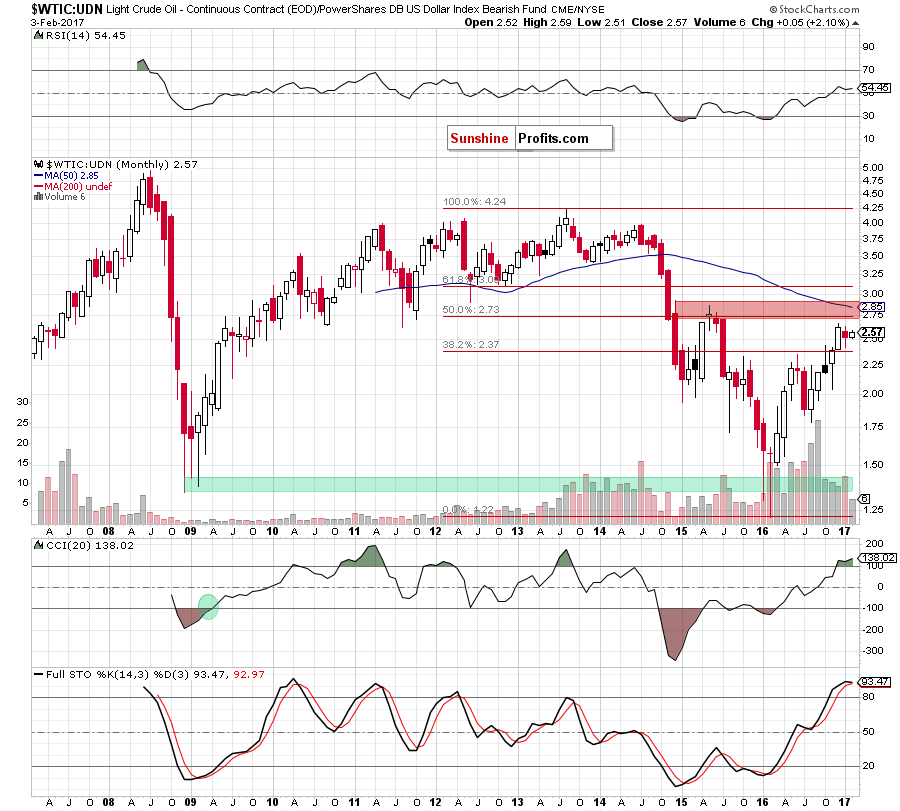
From the long-term perspective, we see that the ratio is still trading under the red resistance zone (created by the 50% Fibonacci retracement, May, Jun and Jul highs and reinforced by the 50-month moving average), which suggests that we may see a reversal in the coming month. This scenario is also reinforced by the current position of the indicators, which increased to the levels not seen since 2013.
On top of that, the picture, which emerges from the medium-term chart also doesn’t bode well for higher values of the ratio and crude oil priced in U.S. dollars.
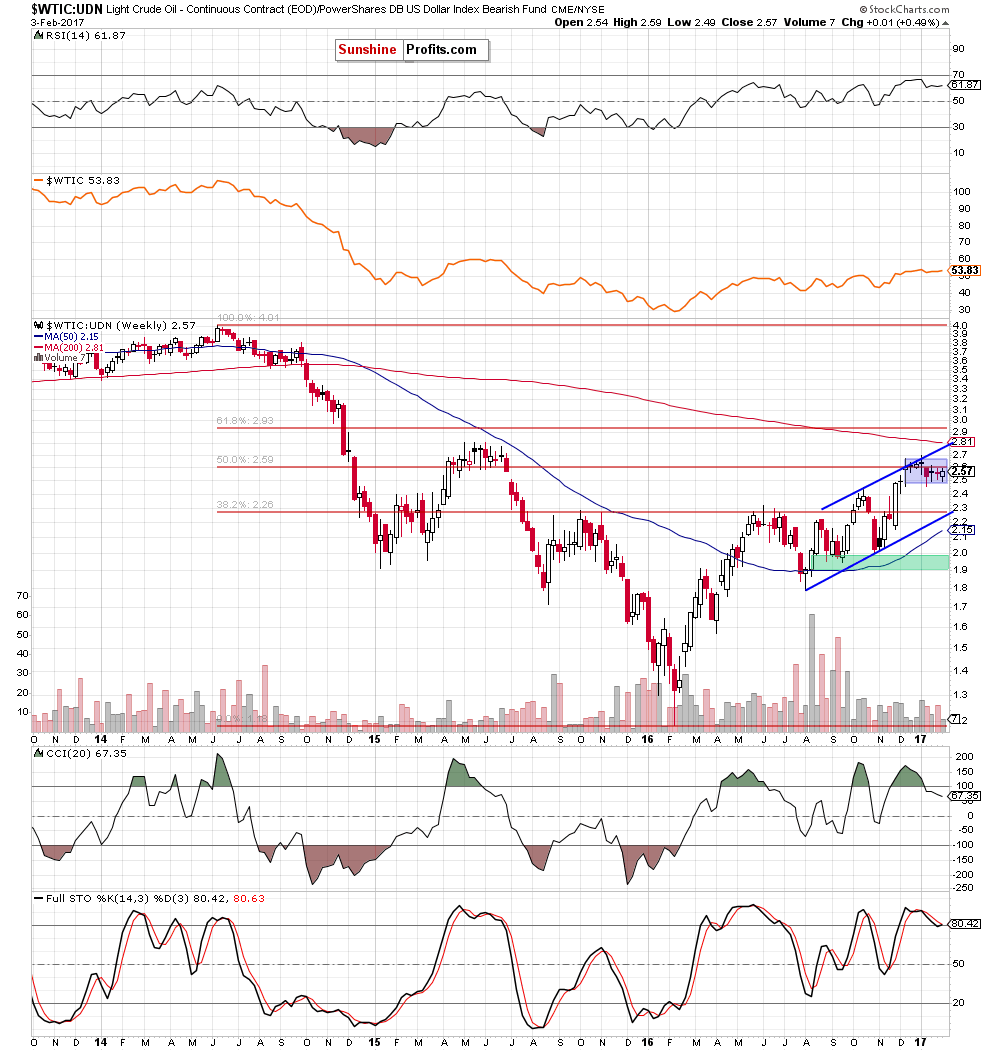
Looking at the weekly chart, we see that although the ratio moved higher in the previous week, it still remains in the blue consolidation under the previously-broken 50% Fibonacci retracement and the upper border of the blue rising trend channel, which suggests that oil bulls may be not as strong as they were in the previous months. Additionally, the CCI and the Stochastic Oscillator generated the sell signals, increasing the probability of a bigger decline in the following weeks - especially after a breakdown under the lower border of the consolidation (at 2.45).
Scenarios
Just like a month ago, today’s Oil Investment Update includes scenarios of what could happen in the coming weeks. Naturally, we will continue to monitor the market in the coming days and if anything invalidates our long-term outlook we will send you an additional message.
- Bullish scenario
If crude oil extends gains and breaks above the January high, we’ll see a test of the red resistance line based on the August and October highs (around $57). If this resistance area is broken, the next upside target for oil bulls will be around $60-$62.58, where the 38.2% Fibonacci retracement (based on the entire 2011-2016 downward move), May and Jun 2015 highs are. - Bearish scenario
If the commodity drops under the lower border of the blue consolidation and the green support line based on the previous lows, we’ll see a re-test of the first support zone created by the Oct high, Dec and Jan lows (around $52.11-$52.49) or even a test of the barrier of $50. If it is broken, the next targets for oil bears will be: around $49 (the 38.2% Fibonacci retracement base on the Aug-Jan upward move and the Nov 22 high), the 200-day moving average (currently at $46.72), around $45.20 (the 61.8% Fibonacci retracement and late-Nov lows), the green support zone created by the May, Sep and early Nov lows (around $42.20-$43) and the barrier of $40.
Summary
Taking all the above into account, we believe that the outlook for crude oil remains bearish as crude oil is still trading under the key resistance zones (the red zone created by the previous highs and the red gap), which together continue to keep gains in check since the beginning of the year. Additionally, the current situation in the gold-to-oil ratio suggests that another bigger move to the downside in the black gold is just around the corner – similarly to what we saw in the past. On top of that, the relationship between oil and oil stocks increases the probability of declines as the oil-to-oil stocks ratio reached the key resistance zone once again (in all previous cases oil bulls didn’t manage to break above it, which resulted in a correction). If this is the case and crude oil extend losses from current levels, we’ll see a realization of the bearish scenario in the coming week(s).
Very short-term outlook: bearish
Short-term outlook: mixed with bearish bias
MT outlook: mixed
LT outlook: mixed
This completes this month’s Oil Investment Update. Our next Oil Investment Update is scheduled for Thursday, March 9, 2017 (we may publish it earlier, but we don't want to commit at this time). Oil Trading Alerts subscribers will additionally receive similar but shorter alerts on a daily basis (or more than once a day when the situation requires it). You – Oil Investment Updates subscribers – will receive short Investment Alert messages should the outlook for the medium or long term change before the next Update is posted.
Thank you.
Nadia Simmons
Forex & Oil Trading Strategist
Oil Investment Updates
Oil Trading Alerts



